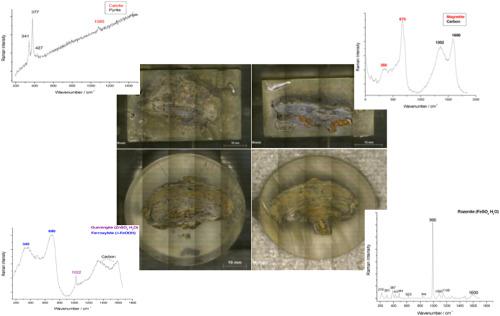当前位置:
X-MOL 学术
›
J. Raman Spectrosc.
›
论文详情
Our official English website, www.x-mol.net, welcomes your
feedback! (Note: you will need to create a separate account there.)
The interaction of sediments with the archeological iron remains from the recovery shipwreck of Urbieta (Gernika, North of Spain)
Journal of Raman Spectroscopy ( IF 2.4 ) Pub Date : 2020-07-06 , DOI: 10.1002/jrs.5944 Estefania Estalayo 1 , Julene Aramendia 1 , Ludovic Bellot‐Gurlet 2 , Laura Garcia 3 , Iñaki Garcia‐Camino 3 , Juan Manuel Madariaga 1, 4
Journal of Raman Spectroscopy ( IF 2.4 ) Pub Date : 2020-07-06 , DOI: 10.1002/jrs.5944 Estefania Estalayo 1 , Julene Aramendia 1 , Ludovic Bellot‐Gurlet 2 , Laura Garcia 3 , Iñaki Garcia‐Camino 3 , Juan Manuel Madariaga 1, 4
Affiliation

|
Cultural heritage often brings to mind elements like sculptures, paintings, monuments, and buildings as well as archeological objects. Today, underwater heritage and its surrounding environment are also considered part of cultural heritage because communities identify themselves with the natural landscape. This study is focused on a shipwreck belonging to the second half of the 15th century that was discovered in 1998 by chance in the sediments of the Urdaibai estuary, in Urbieta (Gernika, Basque Country), at 4 m underground. A scientific study presented in this work was performed, as this archeological site was absolutely out of context and in need of a preservation and conservation procedure. Therefore, our aim was to shed light on the origin of the shipwreck and to assess the conservation state to develop a precise conservation plan. Pursuing this objective, a first analysis on three selected groups of iron nails was performed, looking at the raw materials and degradation patterns through the knowledge of the alteration compounds. By means of nondestructive analytical techniques such as Raman spectroscopy and X‐ray fluorescence, the presence of iron, zinc, and silicon was detected in the outer layer of the iron samples. The analysis of the nails and wood of the shipwreck confirmed that the presence of zinc in the pieces indicates an important impact of the contaminated sediments deposited in the last 80 years on the upper part of the burial in which the shipwreck was located.
中文翻译:

沉积物与考古遗骸的相互作用来自于乌尔比塔(西班牙北部杰尔尼卡)的沉船沉船
文化遗产通常会让人联想到雕塑,绘画,纪念碑和建筑物等元素以及考古文物。如今,水下社区及其周围环境也被认为是文化遗产的一部分,因为社区将自己视为自然景观。这项研究的重点是15世纪下半叶的一次沉船事故,该沉船于1998年在地下4 m的Urbieta(盖尔尼卡,巴斯克地区)的Urdaibai河口沉积物中偶然发现。由于该考古遗址完全脱离环境,需要进行保存和保护程序,因此进行了这项科学研究。因此,我们的目的是阐明沉船的起源并评估保护状态以制定精确的保护计划。为实现这一目标,对三组选定的铁钉进行了首次分析,通过了解变质化合物来了解原材料和降解方式。通过拉曼光谱和X射线荧光等无损分析技术,可以检测到铁样品外层中铁,锌和硅的存在。对沉船钉子和木头的分析证实,碎片中锌的存在表明,过去80年沉积的受污染沉积物对沉船所在的坟墓上部产生了重要影响。通过拉曼光谱和X射线荧光等无损分析技术,可以检测到铁样品外层中铁,锌和硅的存在。对沉船钉子和木头的分析证实,碎片中锌的存在表明,过去80年沉积的受污染沉积物对沉船所在的坟墓上部产生了重要影响。通过拉曼光谱和X射线荧光等无损分析技术,可以检测到铁样品外层中铁,锌和硅的存在。对沉船钉子和木头的分析证实,碎片中锌的存在表明,过去80年沉积的受污染沉积物对沉船所在的坟墓上部产生了重要影响。
更新日期:2020-07-06
中文翻译:

沉积物与考古遗骸的相互作用来自于乌尔比塔(西班牙北部杰尔尼卡)的沉船沉船
文化遗产通常会让人联想到雕塑,绘画,纪念碑和建筑物等元素以及考古文物。如今,水下社区及其周围环境也被认为是文化遗产的一部分,因为社区将自己视为自然景观。这项研究的重点是15世纪下半叶的一次沉船事故,该沉船于1998年在地下4 m的Urbieta(盖尔尼卡,巴斯克地区)的Urdaibai河口沉积物中偶然发现。由于该考古遗址完全脱离环境,需要进行保存和保护程序,因此进行了这项科学研究。因此,我们的目的是阐明沉船的起源并评估保护状态以制定精确的保护计划。为实现这一目标,对三组选定的铁钉进行了首次分析,通过了解变质化合物来了解原材料和降解方式。通过拉曼光谱和X射线荧光等无损分析技术,可以检测到铁样品外层中铁,锌和硅的存在。对沉船钉子和木头的分析证实,碎片中锌的存在表明,过去80年沉积的受污染沉积物对沉船所在的坟墓上部产生了重要影响。通过拉曼光谱和X射线荧光等无损分析技术,可以检测到铁样品外层中铁,锌和硅的存在。对沉船钉子和木头的分析证实,碎片中锌的存在表明,过去80年沉积的受污染沉积物对沉船所在的坟墓上部产生了重要影响。通过拉曼光谱和X射线荧光等无损分析技术,可以检测到铁样品外层中铁,锌和硅的存在。对沉船钉子和木头的分析证实,碎片中锌的存在表明,过去80年沉积的受污染沉积物对沉船所在的坟墓上部产生了重要影响。











































 京公网安备 11010802027423号
京公网安备 11010802027423号